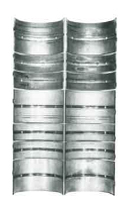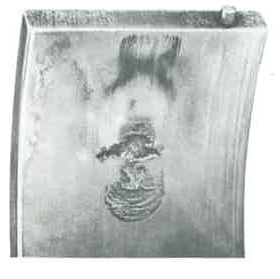Bearing Damage Index
Cavitation Erosion
Cavitation erosion is an impact fatigue attack caused by the formation and collapse of vapor bubbles in the oil film under conditions of rapid pressure changes during the crank cycle in internal combustion engines. The harder the bearing material, the greater its resistance to cavitation erosion.
Addressing the Damage
Continued use of the affected bearings will depend upon the severity and extent of the cavitation erosion.
To limit or reduce damage from cavitation erosion, several options should be investigated:
- Increasing the oil feed pressure
- Modifying the bearing groove, blending edges or contours of grooves to promote streamline flow
- Reducing running clearance
- Changing to a harder bearing material

Figure 1: Set of diesel engine main bearings showing cavitation erosion of soft overlay while harder tin aluminium is unattacked

Figure 2: Section through main bearing illustrating mechanism of cavitation and modification to groove to limit or reduce damage

Figure 3: Cavitation erosion of ungrooved whitemetal-lined bearing occurring downstream of bearing joint face and groove in the other half

